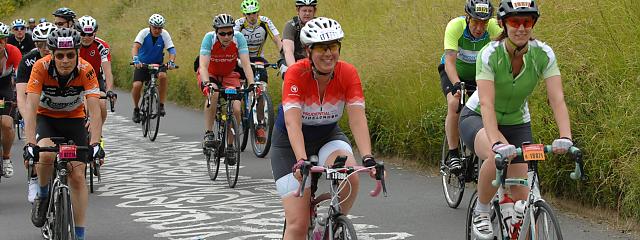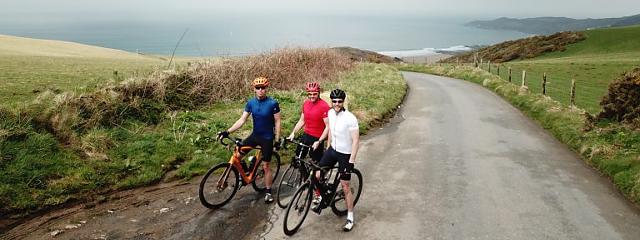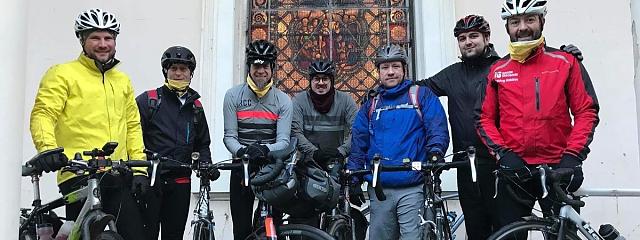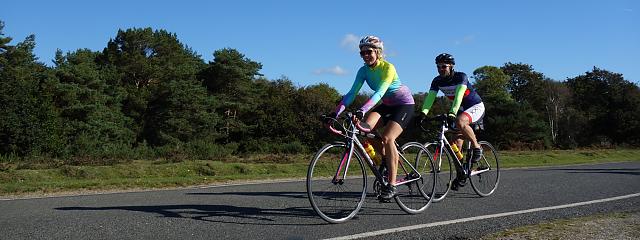
How to organise a charity bike ride or sportive
How to organise a charity bike ride or sportive
Cycling is an ideal activity for charity fund-raising. It’s very inclusive and you’re on to a winner right from the start because people simply won’t believe how far it’s possible to ride as a virtual novice, so the ‘jubilation level’ at the end when your riders find they have successfully ridden 25, 50, 100 or 1,000 miles will be enormous. And they’ll all want to come back for more next year!
Planning
A lot will depend on the size and type of event you are planning. If it’s involving fewer than 20 people and you’re just riding round a field, then there is much less to do than if you are organising a 100-mile ride on the public highway for 100 riders. Plan well ahead, use your common sense, leave nothing to chance and you’re well on your way to a successful event already.
This information is primarily for organisers of short one-day events. There is some supplementary info for people organising longer events. It provides an overview of some areas you must consider, rather than a comprehensive guide.
A Sunday is probably the best day for a charity ride because traffic levels are usually at their lowest, especially Sunday mornings.
Also, choose a time of year when the weather is likely to be warm and dry. June is more likely to be better than November, although there'll be more competing events at that time of year.
Informing the police and local authorities
There is no legal requirement to notify the authorities of your proposed event, unless you are hoping to have a closed road route or it could be construed as being one of the following activities that:
- demonstrate support for or opposition to the views or actions of any person or body of persons
- publicise a cause or campaign, or
- mark or commemorate an event.
Then advance notice must be given, unless it is not reasonably practicable to do so. The notice must specify:
- the date when it is intended to hold the procession
- the time when it is intended to start it
- its proposed route, and
- the name and address of the person (or one of the persons) proposing to organise it.
It must be delivered at least six days before the event.
However, you may wish to do so as a courtesy but be prepared for a less than positive response, although they have no powers to actually ban or stop the event.
In the first instance, enquiries with regard to the planning of public events should be directed to the Safety Advisory Group (SAG) of your local authority: In Scotland, email the relevant Emergency, Event and Resilience Planning Unit for your area requesting the Form 107-001.
Insurance
Don’t even think about organising an event without taking it out comprehensive insurance to protect not only yourself as event organiser but anybody involved in helping run it and the general public.
Third Party/Public Liability Insurance: the organiser needs to have this and, in an ideal world, participants will have it as well. If they don’t have it, and they have a collision involving a third party, then the liability could be passed on to the organiser. In such a case, although unproven in case law, the ‘disclaimer’ is all the more important. You want to aim to have both. You’ll need to take out public liability insurance at least to the limit of £1 million, though you may feel a higher limit is appropriate.
Cycling UK's Organisers' Liability insurance for affiliated groups provides up to £10 million of cover for £75 a year (depending on the size of the event) and provides cover for all volunteers involved in the running of an event, subject to our Terms and Conditions. Individual riders may, in addition, then take out their own Third Party liability insurance at a cost of £24 per year and become Cycling UK Affiliate members.
Affiliating to Cycling UK also brings the benefit that you can register your event with us and it will then appear in our list of UK Cycling Events and therefore reach a wider audience.
Alternatively, you might choose to approach a local Cycling UK group to see if they will adopt the event as one of theirs. As a registered event organiser and a member of Cycling UK, you will be covered by Cycling UK’s Organisers' Liability insurance for Member Groups, again subject to our Terms and Conditions. However, the local group would clearly need to be identified as the main organiser of the event.
Another option is to hold your event during Bike Week – usually held in mid-June every year. Events held during this week and either side of it that are registered as official Bike Week events are automatically insured. However, as ever, don’t forget to read the small print!
Finance
Organising a charity ride costs money and you might need a registration fee from participants to cover your organising costs, even before any money can be raised for your chosen charity. You might want to seek sponsorship from a local business in exchange for promotional opportunities. The following costs, amongst others, will need to be considered, depending on the size of your event:
- Insurance
- Marquees if needed
- Hire of village halls
- Leaflet printing/publicity
- Marshals' jackets
- First aid
- Trestle tables and chairs
- PA equipment
- Catering
- Certificates/medals for the finishers
- Goodie bags
- Mechanical support
- Sag wagon for picking up riders unable to finish
- Portaloos
- Timing chips/electronic timing
The larger charities often have funds available to assist with the organisation of events aimed at swelling their coffers and they should also be able to provide you with marketing materials for your participants and may even have fundraising packs.
Advertising/publicity
You can spend a lot of money on publicity so spend wisely. Promoting your event can be achieved in many ways, including putting up posters, distributing leaflets, contacting local media, putting information on social media and so on. Don't forget to contact local radio stations, local newspapers, local magazines and cycling magazines. Make sure you plan well ahead and find out when their deadlines are. Costs can sometimes be reduced by including advertising for sponsors such as local bike shops and cafes in the programme or any publicity material.
PR is another important tool in your armoury. If you can find someone with experience, it helps because writing a good press release is harder than it looks. Be relevant, be brief and write all the most important information at the beginning. Try to get a local celebrity or dignitary involved somehow. And when you send out your press releases, include a good photo or two.
Marshals and other officials
The number of people needed to assist on the day can be considerable, so before you even consider organising your event, ensure you have the necessary support.
In your initial planning, it’s a good idea to get in touch with regular fundraising groups in your area, eg Rotary, Lions, etc. It’s possible they could help find willing volunteers.
The people you use to help you are an essential ingredient for the success of the event. Make sure you keep them informed of what’s going on in all departments. If you’re short of people, ask your volunteers to find a friend of theirs who will help. Incentivise them with a free barbecue after the event. Remember - the larger the event, the more people you will need to help at the beginning, at the end and in the middle as well.
Here are just some of the tasks you may want marshals for: car parking, information desk, registration,/signing on, catering, marshalling at junctions, signing and stamping completion forms at the end.
Marshals on the road should all wear reflective jackets and must not seek to regulate the flow of traffic- they are not allowed to do this. Their primary role is to warn riders of any hazards, for example at junctions or where there is an uneven road surface or a particularly steep descent.
Route planning
There are many different ways of planning a route, from using Ordnance Survey maps to online route mapping services or websites such as Strava and so on. A list of things to consider when planning the route could include:
- Start point - facilities, parking, proximity to public transport
- Destination - how to get back from if not start point, facilities, proximity to public transport
- Distance and terrain
- Need to ride via anywhere?
- Additional mileage
- Time available
- Scenic or direct
- Traffic OK or as little as possible
- Overnights required (where)
- Type of accommodation
- Number on ride
- Purpose of ride
- Will you have back-up?
- Experience of riders
- Weather/climate
- Availability of marshals or ride leaders and so on....
If the route is a circular one, an anti-clockwise direction is preferable to minimise right turns. A figure-of-eight loop with your main event headquarters at the centre is a good way to organise a longer ride or offer a choice of distances to encourage those who might not feel up to completing the whole distance.
There’s a lot more to planning a route than just poring over a map, whether it’s on screen or on paper. A little thought will lead you quickly to appreciate that a route between two places may need to be very different, depending on a whole range of factors, including the ability of the cyclists in the group, the type of accommodation you need if it’s a multi-day route, whether you want to allow time out for sightseeing and so on. A personal inspection of the route early on in the planning is highly recommended. Try to ride it, not drive it! This will highlight any issues you need to take account of in your risk Assessment.
Once you know roughly what your route will be, submit a draft route to the police well in advance of the anticipated day, for their comments and advice. They should also know if the anticipated date will coincide with any other major event in the area on that day. The police will be able to advise about any problems such as road works too.
It is preferable that the roads used are minor ones, only passing along major roads if absolutely necessary. The local Cycling UK group could possibly help with the route planning as they usually know their locality well.
Managing risk
risk assessments are important in limiting your potential liability should anything untoward happen. By carrying out a risk assessment, you are showing that you are a thoughtful organiser, who has considered all the potential risks and dangers, minimised or removed them where practicable, and have plans of action in place for any like scenarios. You can find our suggested risk Assessment form below. Marshals and/or signs are essential particularly when crossing or using main roads. This is especially important on larger events.
Refreshments
Important to think about when planning a route is the provision of eating and drinking stops, not to mention toilets. Are you ‘doing it yourself’ or using commercial establishments along the way? Local pubs can be helpful and sometimes village halls can be hired for the day. Assuming there will be novice riders, do not plan the stops too far apart; i.e. on a 50-mile ride stops should be at approximately 10, 25 and 38 miles. Don't forget to pre-warn establishments if you expect more than, say, 10 to 15 riders to turn up at once - nobody likes having to queue in the middle of a ride and waste time or - even worse! - find that the food has run out! Obviously it's a good idea to warn riders, especially novices, to bring a small amount of food and drink along for their own consumption - they may underestimate how much they need to sustain themselves on a ride.
Toilets
Participants, especially older, younger and female riders, will appreciate these at the start, finish and during a ride. During your risk assessment, you can figure out the location of any public facilities and include them on your route where possible. The Great British Toilet Map can help with this!
Other facilities
An experienced and qualified mechanic or two are always useful. One at the start can help with any immediate problems. He/she can then go out on the road and park at an appropriate place along the route. It’s no problem asking participants to pay for any spares used in repairing their machine; just make sure you mention this in the preliminary notes on the ride so they remember to carry some cash with them. But note that our Organisers' Liability policy does not cover repairs or adjustments to machines so check that any mechanics you use have their own or ask our brokers Butterworth Spengler for a quote.
First aid
Ensure that qualified first aiders are present throughout the day, depending on the size of the ride. The Red Cross or St John Ambulance are used to turning out for this kind of event but be aware, they do charge a fee. Note that we recommend that nobody attempts first aid unless they are qualified. In your Emergency Operating Procedures note down what should happen in an emergency and brief all of your marshals and other volunteers accordingly. It is useful to have a note of any grid references or postcodes to help direct emergency services to the scene. All major incidents should be recorded on an Incident Report form.
Registering riders
Do get your riders to pre-book if possible.This makes the logistics far easier to plan. Large numbers of people entering ‘on the line’ can be awkward and involve handling large sums of money. Online registration is possible through websites such as Eventbrite, Tito and We Got Tickets, although you might have to pay a fee for each participant.
You will want to have the participant’s name and details of who to contact in an emergency and how much they have managed to raise or intend to raise. Cycling UK's Signing On Sheet may be used as a template. Cycling UK's GDPR guidance sets out how this data should be treated once the event is over.
Cycling UK's Safeguarding policy says that young people aged 13 and over may ride unaccompanied by a parent or guardian but all riders aged under 18 (16 in Scotland), whether accompanied or not, must still have a signed parental consent form and should include information that makes it clear that there is no special provision made for young people and that parents/guardians must be clear about the demands of the ride that they are consenting to.
Remember that all riders must be registered for insurance purposes, so have some means of processing participants as they arrive, such as giving them a number to stick on their bike or themselves. If you don’t check them in, you’ll have no way of knowing whether they participated or not (or perhaps just turned up and joined the ride without registering at all). You will also have no way of identifying them in the case of an incident or reaching their emergency contacts. And don't forget to get them to sign back in again so you know who to hand out a certificate to or who is still 'missing in action'.
Riders' information pack
It’s safer to assume your participants have little or no experience, rather than assuming they know everything. Therefore it’s important to brief them fully as to what they’re taking on. This should include:
- Tips on preparing for the ride:
preparing yourself – we have a guide to how to prepare for your first charity cycle ride;
preparing the bike – ensure your bike is in a sound road worthy condition. Our M-check video will show you what riders should look out for. Advise them to take it to a professional if they are in any doubt about their mechanical abilities. - What to wear for the ride
- What to bring on the bike
- Obviously clear details of where and when the ride starts and finishes.
- Where a rider’s support vehicle can safely park (if it’s really necessary to have one)
- Hints on fund raising
- How long the ride is, together with a detailed route sheet and/or map or GPX files plus information on likely terrain, hazards and so forth that you have gathered for your risk Assessment
- Details of any emergency phone numbers riders should call if in trouble
- Who to contact if they decide to go home and not complete the ride - advise them that they must do this if they do not finish the ride.
- Finally, remind riders that they will be cycling on a public highway and they must obey the Highway Code at all times.
Cycling UK's Group Rider checklist has more information that you may want to include.
Sponsorship money
Don’t lose sight of this, the most important aspect of the day. Participants should be responsible for collecting their own sponsorship money and giving it to the organiser. They will need some kind of proof that they have completed the ride, so a certificate of completion or a rubber stamp on their route sheet will be necessary.
Clearly identify a date by which you would like to receive all monies raised. If you obtained an email address for the riders, then it will be cheaper to send them a reminder! However, sending a brief ‘newsletter’ after the ride, saying what a successful event it was etc will encourage people to chase their friends up for the promised fiver.
Don’t forget to get all monies collected ‘Gift Aided’; this allows you to claim back tax paid on it, thereby increasing every donation by about 25%. Speak to your charity about this.
The ride
When setting off, small, well-spaced groups of about 12-15 riders at a time are advisable. Note Cycling UK's insurance does not cover mass start races but non-competitive sportives are generally covered. Cycling UK's Ride Leader Guidelines have more information on how to manage a group ride.
It’s useful for participants to be given a number or letter to wear or fix on their bike (or on themselves), so that they can be identified as they pass checkpoints. Make sure riders don’t obscure their number.
Longer rides, say over 20 miles, with fewer than 200 riders tend to lose their cohesion. It is therefore important to have stops at regular intervals so that the riders feel that they are part of an event.
If the ride is not a circular ride, are you going to supply transport to get the people and cycles back to the start? If this service is to be provided, it must be made clear and fully-costed out and payable in advance. Don't assume that train operators will accept large numbers of cyclists all trying to get back to a start point! A to B Magazine has a list of all UK train operators and their bike restrictions.
Longer events
Whilst much of the above information is aimed primarily at organisers of one-day events, many of the issues raised apply equally to multi-day events, eg a Land’s End to John O’ Groats sponsored ride. Longer events may attract fewer participants which should make your life a bit easier. On the other hand, with a longer event prospective participants are likely to have more questions and also the business of overnight accommodation becomes a significant factor.
Note that if you provide accommodation, ride and transport, this may constitute a 'package' and fall within Government's Package Travel Regulations (1992) and may not be covered by our insurance.
Useful resources
Many of the useful documents mentioned in this article such as the risk Assessment, Incident Report form and so on can be found in our Event Organiser's Toolkit.
Cycling UK is the national cycling charity, supporting and promoting all types of cycling. If you have found these guidelines useful, why not consider affiliating to us or making a donation to support our work? You might even consider organising a charity ride in aid of us or the Cyclists' Defence Fund, or donating a portion of the funds you raise to support our invaluable campaigning work.












